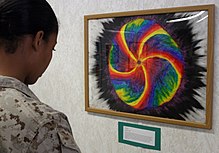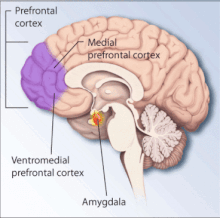പോസ്റ്റ് ട്രൊമാറ്റിക് സ്ട്രെസ് ഡിസോർഡർ
| post-traumatic stress disorder | |
|---|---|
| സ്പെഷ്യാലിറ്റി | Psychiatry, clinical psychology |
| ലക്ഷണങ്ങൾ | Disturbing thoughts, feelings, or dreams related to the event; mental or physical distress to trauma-related cues; efforts to avoid trauma-related situations; increased fight-or-flight response[1] |
| സങ്കീർണത | Self-harm, suicide[2] |
| കാലാവധി | > 1 month[1] |
| കാരണങ്ങൾ | Exposure to a traumatic event[1] |
| ഡയഗ്നോസ്റ്റിക് രീതി | Based on symptoms[2] |
| Treatment | Counseling, medication[3] |
| മരുന്ന് | Selective serotonin reuptake inhibitor[4] |
| ആവൃത്തി | 8.7% (lifetime risk); 3.5% (12-month risk) (US)[5] |
പോസ്റ്റ് ട്രൊമാറ്റിക് സ്ട്രെസ് ഡിസോർഡർ ( post-traumatic stress disorder - PTSD ) അഥവാ മാനസികക്ഷതം എന്നത് [i] ഒരു മാനസികവൈകല്യവും പെരുമാറ്റ വൈകല്യവുമാണ് [6] ലൈംഗികാതിക്രമം, , വാഹനാപകടങ്ങൾ, കുട്ടിക്കാലത്തെ ലൈംഗികദുരുപയോഗം, ഗാർഹിക പീഡനം അല്ലെങ്കിൽ ജീവന് ഭീഷണിയായ മറ്റെന്തെങ്കിലും കാരണങ്ങളാൽ ആണ് ഇത് ഒരാളിൽ രൂപം കൊള്ളുന്നത്.[1][7] ഇത്തരം സംഭവങ്ങളുമായി ബന്ധപ്പെട്ട അസ്വസ്ഥജനകമായ ചിന്തകൾ, വികാരങ്ങൾ, സ്വപ്നങ്ങൾ, ആഘാതവുമായി ബന്ധപ്പെട്ട ഓർമ്മകൾ, ആഘാതവുമായി ബന്ധപ്പെട്ട ഓർമ്മകൾ ഒഴിവാക്കാനുള്ള ശ്രമങ്ങൾ, ചിന്തിക്കുകയും അനുഭവിക്കുകയും ചെയ്യുന്ന രീതിയിലുള്ള മാറ്റങ്ങൾ, വഴക്കുകൂടൽ എന്നിവയും ലക്ഷണങ്ങളിൽ ഉൾപ്പെടാം.[1][3] ഈ ലക്ഷണങ്ങൾ സംഭവം കഴിഞ്ഞ് ഒരു മാസത്തിലധികം നീണ്ടുനിൽക്കും.[1] കൊച്ചുകുട്ടികൾ വിഷമം പുറമേ കാണിക്കാനുള്ള സാധ്യത കുറവാണ്, പകരം കളിയിലൂടെ അവരുടെ ഓർമ്മകൾ പ്രകടിപ്പിക്കാം.[1] PTSD ഉള്ള ഒരു വ്യക്തി ആത്മഹത്യ ചെയ്യാനും മനഃപൂർവ്വം സ്വയം ഉപദ്രവിക്കാനും സാധ്യത കൂടുതലാണ്.[2][8]
രോഗലക്ഷണങ്ങൾ[തിരുത്തുക]

PTSD യുടെ ലക്ഷണങ്ങൾ സാധാരണയായി ആഘാതകരമായ സംഭവത്തിന് ശേഷം ആദ്യത്തെ മൂന്ന് മാസത്തിനുള്ളിൽ ആരംഭിക്കുന്നു, എന്നാൽ വർഷങ്ങൾ കഴിഞ്ഞശേഷം ഇത് ആരംഭിക്കാനിടയില്ല.[1] സാധാരണ സാഹചര്യത്തിൽ, PTSD ഉള്ള വ്യക്തി, ആഘാതവുമായി ബന്ധപ്പെട്ട ചിന്തകളും വികാരങ്ങളും അതേക്കുറിച്ചുളള ചർച്ചകളും സ്ഥിരമായി ഒഴിവാക്കുന്നു, കൂടാതെ സംഭവത്തെക്കുറിച്ച് അയാൾക്ക് ഓർമ്മക്കുറവ് പോലും ഉണ്ടാകാം.[1] പേടിസ്വപ്നങ്ങളാലും ആവർത്തിച്ചുളള ഓർമ്മകളാലും ഇവർ അതിനെ പുനർനിർമ്മിക്കുന്നു. ഏതെങ്കിലും ആഘാതകരമായ സംഭവത്തിന് ശേഷം മനക്ലേശം ഉണ്ടാകുന്നത് സാധാരണമാണെങ്കിലും, ഒരു മാസത്തിൽ താഴെ കാലയളവ് മാത്രമേയുളളുവെങ്കിൽ അതിനെ നേരിയ മാനസികക്ഷതം ആയി കണക്കാക്കാം.[1][9] ചിലർക്ക് ആഘാതകരമായ സംഭവത്തെ തുടർന്ന് ആഘാതാനന്തര മനക്ലേശവർദ്ധന അനുഭവപ്പെടുന്നു.[10]
ആഘാതകരമായ സംഭവം[തിരുത്തുക]
വിവിധതരം ആഘാതകരമായ സംഭവങ്ങളുമായി പിറ്റിഎസ്ഡി ബന്ധപ്പെട്ടിരിക്കുന്നു. ആഘാതകരമായ സംഭവത്തിന് ശേഷം PTSD വികസിക്കുന്നതിനുള്ള അപകടസാധ്യത ആഘാതത്തിൻ്റെ തരം അനുസരിച്ച് വ്യത്യാസപ്പെട്ടിരിക്കുന്നു.[11][12] ബലാത്സംഗം പോലുളള ലൈംഗിക അതിക്രമങ്ങൾക്ക് ശേഷം പിറ്റിഎസ്ഡി ഉണ്ടാകാനുളള സാധ്യത വളരെ ഉയർന്നതാണ്.[13] പുരുഷന്മാർ പലതരം ആഘാതകരമായ സംഭവങ്ങൾ അനുഭവിക്കാൻ സാധ്യതയുണ്ട്, എന്നാൽ സ്ത്രീകൾ മറ്റു വ്യക്തികളിൽ നിന്നുളള അക്രമവും ലൈംഗികപീഢനവുമാണ് കൂടുതൽ അനുഭവിക്കാനിടവരുന്നത് [14]
വാഹനാപകടത്തിൽ നിന്നും രക്ഷപെടുന്ന, കുട്ടികളും മുതിർന്നവരും, മാനസികക്ഷതത്തിൻ്റെ പിടിയിൽ പെട്ടേയ്ക്കാം.[15][16] ആഗോളതലത്തിൽ, മുതിർന്നവരിൽ വാഹനാപകടത്തിൽപെടുന്ന ഏകദേശം 2.6% പേർക്കും മാനസികക്ഷതം ഉണ്ടാകുന്നതായി കാണപ്പെട്ടു.[13] ജീവൻ അപകടപ്പെടുത്തുന്ന വാഹനാപകടങ്ങളിൽ PTSD യുടെ സാധ്യത ഏതാണ്ട് 4.6% കണ്ട് ഇരട്ടിയാണ്.[13] വാഹനാപകടത്തെത്തുടർന്ന് സ്ത്രീകൾക്ക് മാനസികക്ഷതം ഉണ്ടാകാനുളള സാധ്യത കൂടുതലാണ്, അപകടം കുട്ടിക്കാലത്തോ പ്രായപൂർത്തിയായപ്പോഴോ സംഭവിച്ചാലും.[15][16]
ഇണയിൽ നിന്നുള അക്രമം[തിരുത്തുക]
ഗാർഹിക പീഡനത്തിന് ഇരയായ വ്യക്തിക്ക് മാനസികക്ഷതം ഉണ്ടാകാൻ സാധ്യതയുണ്ട്. ഗർഭാവസ്ഥയുടെ പെരിനാറ്റൽ കാലയളവിൽ ഗാർഹിക പീഡനം അനുഭവിച്ച അമ്മമാരിൽ PTSD യുടെ വികസനം തമ്മിൽ ശക്തമായ ബന്ധമുണ്ട്.[17] പ്രസവകാലഘട്ടത്തിലെ ഗാർഹികപീഢനം അമ്മമാരിൽ മാനസികക്ഷതത്തിന് കാരണമാകുന്നു.
യുദ്ധവുമായി ബന്ധപ്പെട്ട ആഘാതം[തിരുത്തുക]
സൈനിക സേവനകാലഘട്ടത്തിൽ മാനസിക ക്ഷതം ഉണ്ടായേക്കാം.[18] യുദ്ധത്തിൽ പങ്കെടുത്ത 78% ആളുകളിലും മാനസികക്ഷതം ഉണ്ടാകുന്നില്ല; ഏകദേശം 25% സൈനിക ഉദ്യോഗസ്ഥരിൽ, വൈകിയ വേളയിൽ മാനസികക്ഷതം ഉണ്ടാകുന്നു.[18]
യൂദ്ധവുമായി ബന്ധപ്പെട്ട അഭയാർത്ഥികളിലും മാനസികക്ഷതം ഉണ്ടാകാറുണ്ട്. അഭയാർത്ഥി ജനസംഖ്യയിൽ PTSD യുടെ നിരക്ക് 4% മുതൽ 86% വരെയാണ്.[19] കുടിയിറക്കപ്പെട്ടവരിൽ ഇത് വളരെ കൂടുതലാണെന്ന് തെളിയിക്കപ്പെട്ടിട്ടുണ്ട്.[20]
പ്രിയപ്പെട്ടവരുടെ അപ്രതീക്ഷിത മരണം[തിരുത്തുക]
പഠനങ്ങളിൽ കൂടുതലായി റിപ്പോർട്ട് ചെയ്യപ്പെട്ടതാണ് പ്രിയപ്പെട്ടവരുടെ വിയോഗം മൂലമുളള ആഘാതം.[13][21] ഇത്തരം സംഭവങ്ങളിൽ ഭൂരിഭാഗം പേർക്കും മാനസികക്ഷതം ഉണ്ടാകണമെന്നില്ല. ലോകാരോഗ്യസംഘടനയുടെ ലോക മാനസികാരോഗ്യ സർവേകളിൽ പ്രിയപ്പെട്ടവരുടെ വിയോഗം മൂലം മാനസികക്ഷതം ഉണ്ടാകാൻ 5.2% സാധ്യതയുളളതായി കണ്ടെത്തി.[21] എന്നാൽ ഇത്തരത്തിലുള്ള ആഘാതകരമായ സംഭവങ്ങൾ വർദ്ധിച്ചുവരുന്നതിനാൽ, പ്രിയപ്പെട്ട ഒരാളുടെ അപ്രതീക്ഷിത മരണം മൂലമുളള PTSD കേസുകൾ ലോകത്തിൽ ഏകദേശം 20% ആണ്.[13]
ജീവൻ അപകടപ്പെടുത്തുന്ന അസുഖം[തിരുത്തുക]
ക്യാൻസർ,[22][23][24] ഹൃദയാഘാതം,[25] പക്ഷാഘാതം എന്നിവ മാനസികക്ഷതം ഉണ്ടാക്കുന്ന രോഗങ്ങളാണ്.[26] ക്യാൻസർ അതിജീവിച്ചവരിൽ 22% പേർക്ക് ആജീവനാന്തം PTSD ലക്ഷണങ്ങൾ ഉണ്ട്.[27] തീവ്രപരിചരണ വിഭാഗത്തിൽ (ഐസിയു) ആശുപത്രിയിൽ പ്രവേശിക്കുന്നതും മാനസികക്ഷതത്തിലേയ്ക്ക് നയിച്ചേയ്ക്കാം.[28] ചില സ്ത്രീകൾക്ക് സ്തനാർബുദം, സ്തനശസ്ത്രക്രിയ എന്നിവയും മാനസികക്ഷതത്തിന് കാരണമായേക്കാം.[22][29][30] മാരകമായ അസുഖങ്ങൾ ഉളളവരുടെ ബന്ധുക്കൾക്കും, മാറാരോഗങ്ങളുളള കുട്ടികളുടെ മാതാപിതാക്കൾക്കും ഇത് ഉണ്ടാകാറുണ്ട്.[31]
ഗർഭധാരണവുമായി ബന്ധപ്പെട്ട ആഘാതം[തിരുത്തുക]
ഗർഭം അലസുന്ന സ്ത്രീകൾക്ക് PTSD വരാനുള്ള സാധ്യതയുണ്ട്.[32][33][34] ആവർത്തിച്ചുളള ഗർഭം അലസലുകൾ അനുഭവിക്കുന്നവർക്ക് പി ടി എസ് ഡി ഉണ്ടാകാനുള്ള സാധ്യത കൂടുതലാണ്.[32] പ്രസവത്തിനു ശേഷവും PTSD ഉണ്ടാകാം, ഗർഭധാരണത്തിനുമുമ്പ് ഒരു സ്ത്രീക്ക് ആഘാതം അനുഭവപ്പെട്ടാൽ അപകടസാധ്യത വർദ്ധിക്കും.[35][36] സാധാരണ പ്രസവത്തിനു ശേഷമുള്ള PTSD യുടെ വ്യാപനം (അതായത്, പ്രസവാനന്തരം ആറാഴ്ചയിൽ 2.8 മുതൽ 5.6% വരെ) 2.8 മുതൽ 5.6% വരെയായിരിക്കുമെന്ന് കണക്കാക്കപ്പെടുന്നു,[37] പ്രസവശേഷം ആറുമാസമാകുമ്പോൾ നിരക്ക് 1.5% ആയി കുറയുന്നു.[37][38] പ്രസവശേഷം PTSD യുടെ ലക്ഷണങ്ങൾ സാധാരണമാണ്, ആറാഴ്ചയികൊണ്ട് 24-30.1% [37] വ്യാപിക്കുന്നു, എന്നാൽ ആറ് മാസത്തിൽ 13.6% ആയി കുറയുന്നു.[39] അത്യാഹിതപ്രസവവും PTSD ക്ക് കാരണമാകാറുണ്ട്.[40]
ജനിതകപരമായി[തിരുത്തുക]
പാരമ്പര്യമായും പിറ്റിഎസ്ഡി ഉണ്ടാകുന്നു എന്നതിന് തെളിവുകളുണ്ട്. ഏകദേശം 30% പിറ്റിഎസ്ഡി ജനിതകകാരണങ്ങളാലാണ് ഉണ്ടാകുന്നത്.[41]

അവലംബം[തിരുത്തുക]
- ↑ 1.00 1.01 1.02 1.03 1.04 1.05 1.06 1.07 1.08 1.09 American Psychiatric Association (2013). Diagnostic and Statistical Manual of Mental Disorders (5th ed.). Arlington, VA: American Psychiatric Publishing. pp. 271–80. ISBN 978-0-89042-555-8.
- ↑ 2.0 2.1 2.2 "Post-traumatic stress disorder". BMJ. 351: h6161. November 2015. doi:10.1136/bmj.h6161. PMC 4663500. PMID 26611143.
- ↑ 3.0 3.1 "Post-Traumatic Stress Disorder". National Institute of Mental Health. February 2016. Archived from the original on 9 March 2016. Retrieved 10 March 2016.
- ↑ ഉദ്ധരിച്ചതിൽ പിഴവ്: അസാധുവായ
<ref>ടാഗ്;Berger-2009എന്ന പേരിലെ അവലംബങ്ങൾക്ക് എഴുത്തൊന്നും നൽകിയിട്ടില്ല. - ↑ Diagnostic and statistical manual of mental disorders: DSM-5 (5th ed.). Arlington, VA: American Psychiatric Association. 2013. p. 276. ISBN 9780890425558. OCLC 830807378.
- ↑ Drs; Sartorius, Norman; Henderson, A.S.; Strotzka, H.; Lipowski, Z.; Yu-cun, Shen; You-xin, Xu; Strömgren, E.; Glatzel, J.; Kühne, G.-E. "The ICD-10 Classification of Mental and Behavioural Disorders Clinical descriptions and diagnostic guidelines" (PDF). www.who.int World Health Organization. Microsoft Word. p. 110. Retrieved 3 July 2021.
- ↑ "Post-traumatic stress disorder (PTSD) - Symptoms and causes". Mayo Clinic. Retrieved 2019-10-08.
- ↑ "Suicidality and posttraumatic stress disorder (PTSD) in adolescents: a systematic review and meta-analysis". Social Psychiatry and Psychiatric Epidemiology. 50 (4): 525–37. April 2015. doi:10.1007/s00127-014-0978-x. PMID 25398198.
- ↑ Satcher D (1999). "Chapter 4". Mental Health: A Report of the Surgeon General. Surgeon General of the United States. Archived from the original on 2010-07-02.
- ↑ "Posttraumatic Growth as a Response to Natural Disasters in Children and Adolescents". Current Psychiatry Reports. 20 (5): 37. May 2018. doi:10.1007/s11920-018-0900-4. PMID 29766312.
- ↑ "Posttraumatic stress disorder: clinical features, pathophysiology, and treatment". The American Journal of Medicine. 119 (5): 383–90. May 2006. doi:10.1016/j.amjmed.2005.09.027. PMID 16651048.
- ↑ Dekel S, Gilbertson MW, Orr SP, Rauch SL, Wood NE, Pitman RK (2016). "Trauma and Posttraumatic Stress Disorder". In Stern TA, Fava M, Wilens TE, Rosenbaum JF (eds.). Massachusetts General Hospital comprehensive clinical psychiatry (Second ed.). London: Elsevier. pp. 380–392. ISBN 9780323295079. OCLC 905232521.
- ↑ 13.0 13.1 13.2 13.3 13.4 "Trauma and PTSD in the WHO World Mental Health Surveys". European Journal of Psychotraumatology. 8 (sup5): 1353383. 2017-10-27. doi:10.1080/20008198.2017.1353383. PMC 5632781. PMID 29075426.
- ↑ National Collaborating Centre for Mental Health (UK) (2005). Post-Traumatic Stress Disorder: The Management of PTSD in Adults and Children in Primary and Secondary Care. National Institute for Health and Clinical Excellence: Guidance. Gaskell (Royal College of Psychiatrists). ISBN 9781904671251.
{{cite book}}:|work=ignored (help) - ↑ 15.0 15.1 "Prevalence of posttraumatic stress disorder among road traffic accident survivors: A PRISMA-compliant meta-analysis". Medicine. 97 (3): e9693. January 2018. doi:10.1097/md.0000000000009693. PMC 5779792. PMID 29505023.
- ↑ 16.0 16.1 "Prevalence of Posttraumatic Stress Disorder among Children and Adolescents following Road Traffic Accidents: A Meta-Analysis". Canadian Journal of Psychiatry. 63 (12): 798–808. August 2018. doi:10.1177/0706743718792194. PMC 6309043. PMID 30081648.
- ↑ "Domestic violence and perinatal mental disorders: a systematic review and meta-analysis". PLOS Medicine. 10 (5): e1001452. 2013. doi:10.1371/journal.pmed.1001452. PMC 3665851. PMID 23723741.
{{cite journal}}: CS1 maint: unflagged free DOI (link) - ↑ 18.0 18.1 "Post-Traumatic Stress Disorder". The New England Journal of Medicine. 376 (25): 2459–2469. June 2017. doi:10.1056/NEJMra1612499. PMID 28636846.
- ↑ "Measuring trauma and health status in refugees: a critical review". JAMA. 288 (5): 611–21. August 2002. doi:10.1001/jama.288.5.611. PMID 12150673.
- ↑ "Forced displacement in Yugoslavia: a meta-analysis of psychological consequences and their moderators". Journal of Traumatic Stress. 14 (4): 817–34. October 2001. doi:10.1023/A:1013054524810. PMID 11776427.
- ↑ 21.0 21.1 "Posttraumatic stress disorder associated with unexpected death of a loved one: Cross-national findings from the world mental health surveys". Depression and Anxiety. 34 (4): 315–326. April 2017. doi:10.1002/da.22579. PMC 5661943. PMID 27921352.
- ↑ 22.0 22.1 "Cancer-Related Post-traumatic Stress". National Cancer Institute. January 1980. Retrieved 2017-09-16.
- ↑ "Posttraumatic stress disorder after cancer diagnosis in adults: A meta-analysis". Depression and Anxiety (Submitted manuscript). 34 (4): 327–339. April 2017. doi:10.1002/da.22542. PMID 27466972.
- ↑ "Post-traumatic stress disorder and cancer". The Lancet. Psychiatry. 4 (4): 330–338. April 2017. doi:10.1016/S2215-0366(17)30014-7. PMC 5676567. PMID 28109647.
- ↑ "Posttraumatic stress disorder prevalence and risk of recurrence in acute coronary syndrome patients: a meta-analytic review". PLOS ONE. 7 (6): e38915. 2012. Bibcode:2012PLoSO...738915E. doi:10.1371/journal.pone.0038915. PMC 3380054. PMID 22745687.
{{cite journal}}: CS1 maint: unflagged free DOI (link) - ↑ "Prevalence of PTSD in Survivors of Stroke and Transient Ischemic Attack: A Meta-Analytic Review". PLOS ONE. 8 (6): e66435. 2013-06-19. Bibcode:2013PLoSO...866435E. doi:10.1371/journal.pone.0066435. PMC 3686746. PMID 23840467.
{{cite journal}}: CS1 maint: unflagged free DOI (link) - ↑ "A meta-analysis of prevalence rates and moderating factors for cancer-related post-traumatic stress disorder". Psycho-Oncology. 24 (4): 371–81. April 2015. doi:10.1002/pon.3654. PMC 4409098. PMID 25146298.
- ↑ "Posttraumatic stress disorder in general intensive care unit survivors: a systematic review". General Hospital Psychiatry. 30 (5): 421–34. September 2008. doi:10.1016/j.genhosppsych.2008.05.006. PMC 2572638. PMID 18774425.
- ↑ "A systematic literature review exploring the prevalence of post-traumatic stress disorder and the role played by stress and traumatic stress in breast cancer diagnosis and trajectory". Breast Cancer: Targets and Therapy. 9: 473–485. 2017. doi:10.2147/BCTT.S111101. PMC 5505536. PMID 28740430.
{{cite journal}}: CS1 maint: unflagged free DOI (link) - ↑ "Association between social support and post-traumatic stress disorder symptoms among Chinese patients with ovarian cancer: A multiple mediation model". PLOS ONE. 12 (5): e0177055. 2017-05-05. Bibcode:2017PLoSO..1277055L. doi:10.1371/journal.pone.0177055. PMC 5419605. PMID 28475593.
{{cite journal}}: CS1 maint: unflagged free DOI (link) - ↑ "PsycNET". psycnet.apa.org. Retrieved 2018-09-30.
- ↑ 32.0 32.1 "Posttraumatic stress disorder in parents following infant death: A systematic review". Clinical Psychology Review. 51: 60–74. February 2017. doi:10.1016/j.cpr.2016.10.007. PMID 27838460.
- ↑ "Complicated grief after perinatal loss". Dialogues in Clinical Neuroscience. 14 (2): 187–94. June 2012. doi:10.31887/DCNS.2012.14.2/akersting. PMC 3384447. PMID 22754291.
- ↑ "Posttraumatic stress and posttraumatic stress disorder after termination of pregnancy and reproductive loss: a systematic review". Journal of Pregnancy. 2015: 646345. 2015. doi:10.1155/2015/646345. PMC 4334933. PMID 25734016.
{{cite journal}}: CS1 maint: unflagged free DOI (link) - ↑ "The aetiology of post-traumatic stress following childbirth: a meta-analysis and theoretical framework". Psychological Medicine. 46 (6): 1121–34. April 2016. doi:10.1017/s0033291715002706. PMID 26878223.
- ↑ "Women's experiences of symptoms of posttraumatic stress disorder (PTSD) after traumatic childbirth: a review and critical appraisal". Archives of Women's Mental Health. 18 (6): 761–71. December 2015. doi:10.1007/s00737-015-0560-x. PMC 4624822. PMID 26264506.
- ↑ 37.0 37.1 37.2 "Posttraumatic stress following childbirth: a review". Clinical Psychology Review. 26 (1): 1–16. January 2006. doi:10.1016/j.cpr.2005.07.002. PMID 16176853.
- ↑ "Post-traumatic symptoms after childbirth: what should we offer?". Journal of Psychosomatic Obstetrics and Gynaecology. 27 (2): 107–12. June 2006. doi:10.1080/01674820600714632. PMID 16808085.
- ↑ "[Predictors of postpartum post-traumatic stress disorder in primiparous mothers]". Journal de Gynécologie, Obstétrique et Biologie de la Reproduction. 41 (6): 553–60. October 2012. doi:10.1016/j.jgyn.2012.04.010. PMID 22622194.
- ↑ Martin, Colin (2012). Perinatal Mental Health : a Clinical Guide. Cumbria England: M & K Pub. p. 26. ISBN 9781907830495.
- ↑ "PTSD and gene variants: new pathways and new thinking". Neuropharmacology. 62 (2): 628–37. February 2012. doi:10.1016/j.neuropharm.2011.02.013. PMC 3136568. PMID 21356219.
- ↑ "NIMH · Post Traumatic Stress Disorder Research Fact Sheet". National Institutes of Health. Archived from the original on 2014-01-23. Retrieved 2014-01-29.
പുറം കണ്ണികൾ[തിരുത്തുക]
- പോസ്റ്റ് ട്രൊമാറ്റിക് സ്ട്രെസ് ഡിസോർഡർ ഓപ്പൺ ഡയറക്റ്ററി പ്രൊജക്റ്റിൽ
- Post traumatic stress disorder information from The National Child Traumatic Stress Network
- Information resources from The University of Queensland School of Medicine
- APA practice parameters for assessment and treatment for PTSD (Updated 2017)
- Resources for professionals from the VA National PTSD Center
| Classification | |
|---|---|
| External resources |
കുറിപ്പുകൾ[തിരുത്തുക]
- ↑ Acceptable variants of this term exist; see the Terminology section in this article.
